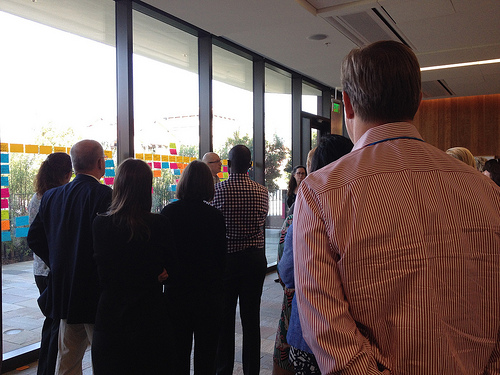
Last week, during the Google hangout hosted by the Packard Foundation, someone asked me where I get all my ideas for designing and delivering training. Part of delivering instruction is being a good facilitation of people’s learning and there is no better way to learn how to improve your own technique than watching world class facilitators in action. Yesterday, I had the pleasure of participating in a convening on “Data Informed Philanthropy” hosted by the Packard Foundation – not only was the content compelling (stay tuned for a post on that), but it was also a fantastic opportunity to observe one of the best facilitators I know, Allen Gunn from Aspiration.
The perfect convening for me is one where I take both content and process notes and leave feeling inspired not only about the subject matter, but the learning design. I first met “Gunner” in 2003 at the NTC Conference in Oakland, CA and participated off and on in Penguin Days expertly facilitated by Gunner and other events like the TechSoup Global Network Summit. I always learn something from his participatory style, humor, and techniques. Here’s a few things I learned.

One of iconic icebreakers that Gunner has used is the “Human SpectraGram” that I first observed Gunner do at 2007 Penguin Day. You have a couple of provocative questions related to the topic you will be discussing or training on and have people line up as to whether they agree or disagree. It is useful method for getting participants to express a point of view, engage in debate, listen to others and respond in how by be influenced by someone’s point of view in the room. For training where you are focusing on a skill, it allows for folks express their opinions (negative or positive) and not have get in the way of the instructional flow later on. My colleague, Dirk Slater, has written about how he applies Gunner’s techniques in his own technology/activist trainings. Others have also documented and used the technique or taught others how to do it.
Typically, the facilitator may come up with a few provocative statements in advance, based on a participant assessment, interviews, or survey. But in this gathering, the provocative questions were crowdsourced from participants and this was done in small groups with sticky notes. Participants volunteered their question for the spectragram.

Gunner also facilitated a brainstorming and affinity mapping exercise to unpack all the possible topics for deep dives in small groups in the afternoon. These techniques are based on human-centered design principles. I’ve used these techniques myself and been in many other sessions where facilitators used design-thinking techniques. What I love seeing is the variation and nuances of how the affinity mapping is facilitated. In this example, people worked in small groups to brainstorm questions and then placed them on the wall in different categories identified through the participant interviews/surveys ahead of the meeting. The full group report out facilitated discussion and refinement of the ideas. In some instances, you might need a longer amount of time to do this exercise, but the way this was facilitated with 50 people was highly productive and efficient.

Good participatory design and instructional design for that matter needs a closure exercise. There are usually two aspects of this. The first is on a practice level – what should happen next? What commitment are we saying to everyone that we will make, should make, or the host should know. Again, we worked in small groups and brainstormed ideas according to: I will commit to this (I committed to writing a blog post or two), I’ll participate if someone else organizes, and what the host should know. The final part of a closing exercise is the pass the mic — which helps bond the community and give a spiritual ending to the day. It is a technique that is used in Open Space design.
I find inspiration from reading about new techniques, observing them in action by masters, writing about it, trying it, and reflecting on it.
If you facilitate meetings or trainings, how you get better at your tradecraft?
Beth Kanter is a consultant, author, influencer. virtual trainer & nonprofit innovator in digital transformation & workplace wellbeing.

Leave a Reply